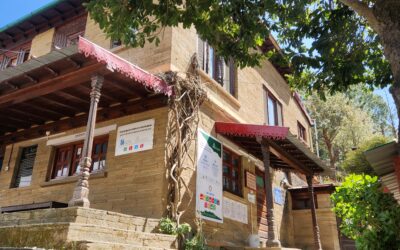In hindsight, when my colleague and I first set out to learn the basics of Lambani embroidery from Ambika Ji, we imagined it simply as a technique—a way of stitching pieces of fabric together and adding surface embellishments. It was a gesture born out of curiosity and an effort to break the ice with our future collaborator. What we couldn’t have anticipated was how those stitches would open up entire worlds, woven into the fabric itself.
This resonates deeply with the ethos of Local Techno Futures, a project rooted in reimagining technologies in a place-based manner, with and for the people who use them. At its core, the project challenges the myth of technological neutrality, emphasizing that all technologies are shaped by the contexts, cultures, and people who create and use them. Lambani embroidery, we learned, is itself a form of technology—a practice that transforms everyday materials, a way of interfacing with the world. Through the process of co-creation with Ambika Ji, we learned about what was being stitched onto the fabrics—the histories, values, and lived realities of their makers.

Threads Of Kinship
Ambika Ji is a long-term collaborator with the Living Labs Network and the resident artist-practitioner for Local Techno Futures. A mother of four, she has been practicing Lambani embroidery since her early teens. When we first visited her home in Bidar, she welcomed us with her daughter, and together they introduced us to a room full of embroidery materials, fabrics, tools, and sewing machines. It was here that we sat down to learn our first stitches of Lambani embroidery.
With needles in hand, we began with the vele stitch, a chain stitch. Ambika Ji demonstrated it on her patch of cloth, and then we tried to replicate it. She watched us carefully, offering tips and occasionally praising us as quick learners—though only for the first few stitches, I suspect.
As we stitched, stories flowed. When we practiced the maki stitch, which resembles colorful mosquitoes decorating a fabric, Ambika Ji laughed and shared a joke:
“Jab saas khet se ghar aake bahu ko dekhti aur puchti tu kya karti sara din, toh bahu bohot sara maki seel ke dikhati, dekho mai maki maari.”
Lambani fabrics alike vessels of kinship. It is customary for mothers to create embroidered pieces for their daughters and their in-laws as part of marriage traditions.
Embroidered Maps Of Communal Pasts
We also learned the rela stitch, which resembles a rail track. When I asked if its name was inspired by the railways, Ambika Ji affirmed it. While practicing, I contemplated what colonial modern technologies like the railways might have meant for this community. One of the primary livelihoods for the Lambani community was the trade of salt (laman). That is, in fact, where they get the name Lambani from. There is much scholarship that captures how colonial technological impositions have ruptured the social fabrics of many indigenous communities. When I shared the thought with Ambika ji, she had little to say on the matter.
A quick glance around the room where we sat to stitch gave me many curiosities. Particularly, I wanted to know how old coins and koudis (shells) came to be used in their art. Pointing to coins and koudis used in her embroidery, she explained that these items were old forms of currency. Laughing, she said, “agar hum uss waqt ke coins use karte toh koi humko utha ke le jata!” For her, these materials symbolized Lambani women’s creativity and resourcefulness, transforming the mundane into something meaningful.
An Emergent Creative Practice
As we practiced, Ambika Ji and her daughter opened an old suitcase filled with sarees and dresses she had embroidered. Unfolding them one by one, she reflected on her process. Each piece displayed intricate needlework that left us in awe. When we asked how long it took to complete such elaborate designs, she said, “ek baar kaam pe baith jaayein toh khatam karke hi rukti thi main.” For her, embroidery was not just a skill but a sacred, meditative practice.
Despite their apparent perfection, she pointed out parts of the designs she had reworked or adapted. Curious about her approach, I asked if she created schematics or planned her designs beforehand. She seemed puzzled by the question, as if pre-designing was an alien concept. “Design pehle soch ke, fir nahi bana sakte bete. Banate banate sochte, usko khud banne dete,” she said. Her words were a gentle reminder that creativity doesn’t always require control. It can emerge spontaneously, grounded in the act of making itself with whatever resources are available.
Reflecting on my own process, I realized how often I micro-plan my work, seeking a false sense of control. Even our meeting with Ambika Ji had been meticulously planned. Yet, in her calm, unhurried way, she taught us the beauty of allowing things to take shape naturally.

Imagining Patchwork Futures
That day, we learned four stitches—vele, bakiya, rela, and maki. Each of them was more than a technique; they were lines on a map of interconnected histories and imagined futures. Ambika Ji’s approach to embroidery embodies the ethos of Local Techno Futures. It reminds us that technologies—whether digital systems or handcrafted stitches—are never neutral. They are shaped by the hands, lives, and stories of those who create them.
As I reflect on our time with her, I realize how much I’ve unlearned and relearned—not just about embroidery, but about ways of being, creating, and connecting. The stitches we made that day are, for me, threads of a patchwork—a patchwork future where pasts and presents fold into new possibilities, one emergent thread at a time.




0 Comments